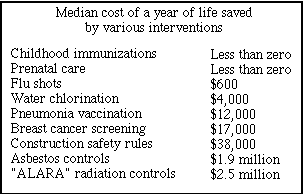A Closer Look At Studies: Cost of Controlling Radiation Exposure
The nuclear industry has controlled radiation exposure for many years based on the principle of keeping doses As Low As Reasonably Achievable (ALARA). In theory, this is not a bad standard, but a great deal of time and money hinge on interpretation of the word “reasonable.”
In the nuclear industry, one of the most heavily regulated and watched businesses in the country, costs have not normally been considered in determining whether or not a new requirement for limiting exposure was reasonable.
According to a study done by the Harvard School of Public Health’s Center for Risk Analysis, it costs an average of $2.5 million dollars for every year of human life saved by adherence to the principles of ALARA in nuclear power plants.
Assumption or Science?
That study was based on the assumption that there is a linear relationship between the risk of death from cancer and radiation dose even at extremely low levels of exposure. Most of the lives that were assumed to be saved in the Harvard study were those of early deaths cancer sufferers whose disease might have been caused by low level radiation.
An increasing number of studies of very large populations of people exposed to low levels of radiation indicate that there is no risk at all below a certain threshold of exposure. Specialists in the field, like Dr. Rosalyn Yalow, Dr. Bernard Cohen, and Dr. Sohei Kondo attribute the existence of a threshold to the biological repair mechanisms inherent in human beings. (See AEI May 1995)
If there is a threshold below which no cancers will be caused, then the Harvard study greatly underestimates the cost of saving a single year of human life by protecting human populations from exposure to radiation from nuclear power plants and radioactive waste materials.
Some might say any cost is justified to save a life. But, resources are not infinite and must be balanced among a variety of needs. The following table puts the lifesaving cost of radiation controls in perspective by comparing them to other programs as reported by Harvard in their Lifesaving Study. (Note: for the first two items on the list, the savings in health care outweigh the cost of the treatment, so the calculated cost of the cure is less than zero.)

